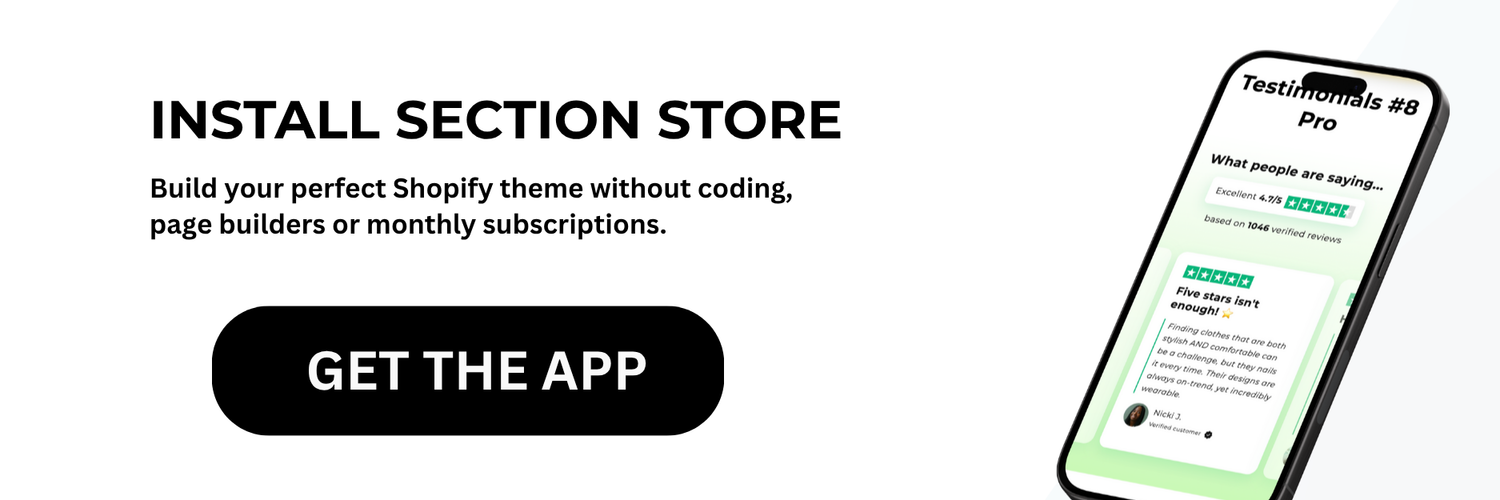The Strategic Power of Shopify Landing Pages
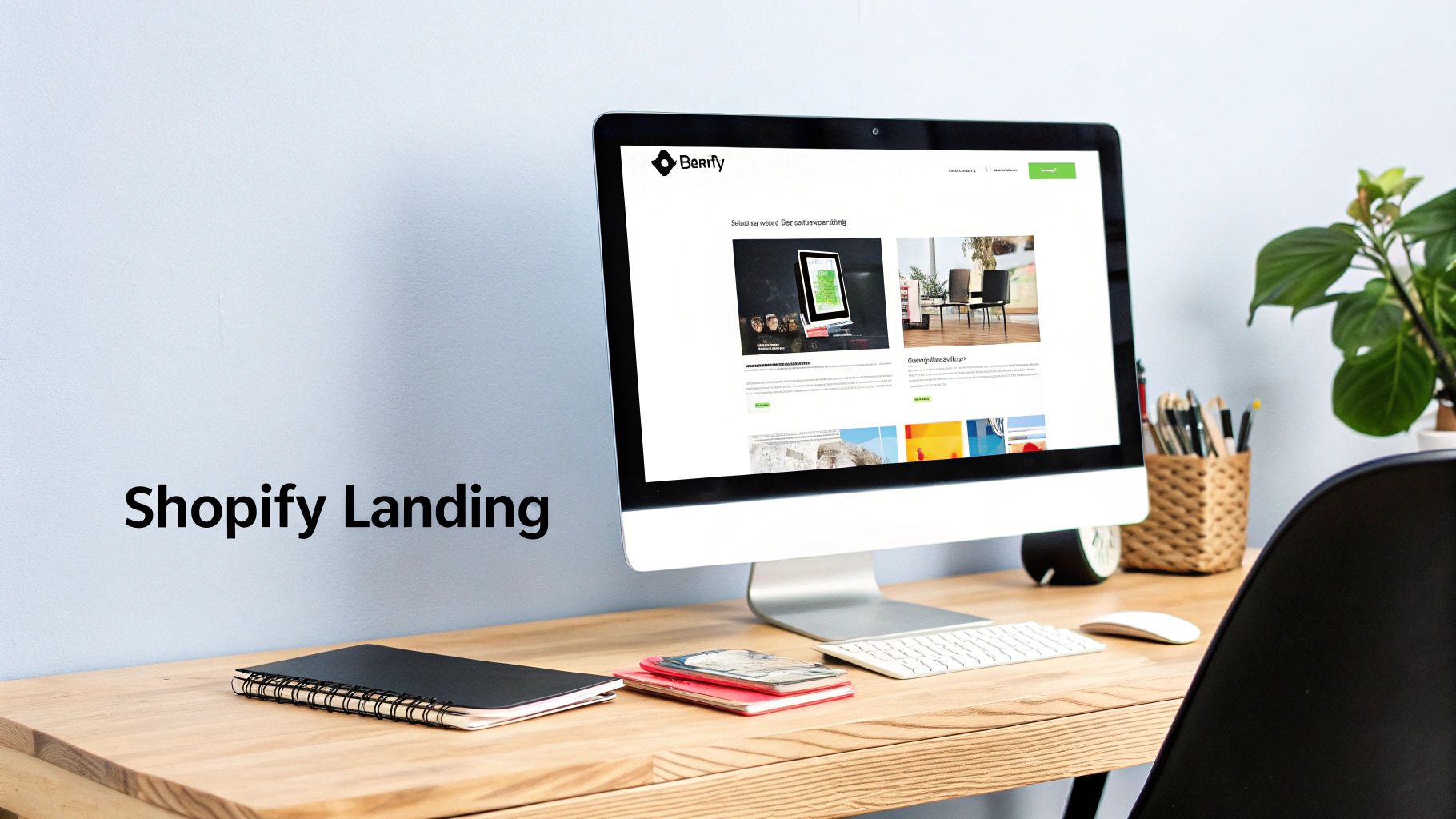
A landing page in Shopify isn't just another page on your website. Think of it as a dedicated space with a single, laser-focused goal: turning visitors into paying customers. Unlike your regular product or collection pages, which allow for browsing, landing pages simplify the buying process. They focus on a particular promotion or offer.
This focused approach eliminates distractions, guiding visitors toward a specific action. This might be completing a purchase, subscribing to your newsletter, or downloading a helpful guide. A streamlined experience like this makes it easier for potential customers to take the next step.
For example, let's say you're running a Facebook ad for a summer flash sale. When someone clicks that ad, they should land directly on a page showcasing those discounted products, not your general homepage. This direct link reinforces your ad's message and provides a consistent experience, building trust and increasing the likelihood of a sale. The customer finds exactly what they were promised.
In addition, landing pages are the perfect testing ground for A/B testing. Experiment with different headlines, images, calls to action, and even page layouts. See what connects best with your target audience. This ongoing process allows you to constantly improve your landing pages and boost those all-important conversion rates. Landing pages are essential for Shopify stores because they significantly improve conversion rates by aligning content with specific marketing campaigns. For instance, a dedicated landing page for a spring sale can boost engagement and conversions. This provides a consistent message, which gives customers confidence in your brand.
Furthermore, landing pages are perfect for A/B testing, allowing you to refine elements like headlines and calls to action. These tweaks drive further conversions. Learn more about optimizing landing pages with Instant.so. This focused optimization significantly impacts your store's overall marketing success.
Why Landing Pages Matter in Your Shopify Strategy
Think of your homepage as a bustling marketplace with various products and services. In contrast, a landing page is like a specialized boutique, curated for a specific customer and purpose. This targeted approach delivers powerful results. By sending targeted campaign traffic to dedicated landing pages, you create a smooth and persuasive customer experience.
This makes your Shopify landing page a crucial component in driving sales and reaching your marketing goals. It’s a vital part of any successful strategy.
Building Your First Landing Page in Shopify That Converts
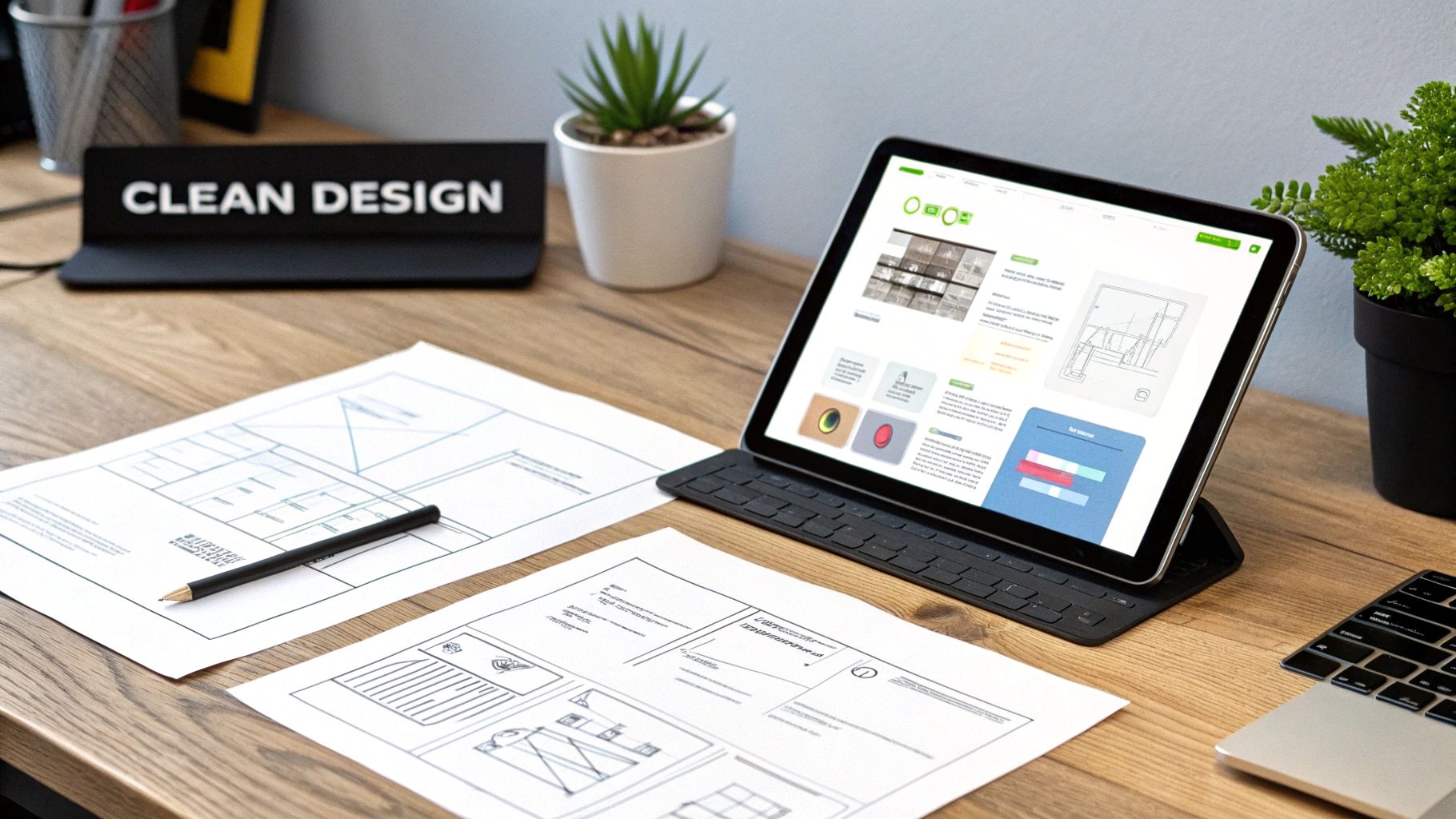
Creating a high-converting landing page in Shopify doesn't require coding skills. It's easier than you might think. First, define your objectives. What do you want to achieve?
Perhaps you're aiming to boost sales for a particular product. Maybe you want to grow your email list. Or, you could be driving registrations for an event. Clear goals are essential for landing page success.
Choosing The Right Method For Your Needs
Once you've set your objectives, several options are available for building your landing page in Shopify. You can use Shopify's built-in page editor, choose a Shopify theme with landing page templates, or opt for a third-party app. Each offers different advantages.
Shopify's built-in page editor is the simplest choice. It's perfect for quickly creating basic landing pages. For more advanced layouts and features, a Shopify theme with dedicated landing page templates provides a balance between ease of use and customization. Third-party apps offer the most flexibility and advanced features but may involve a learning curve and often have a cost. Choose the option that aligns with your skills and resources.
To help you decide, we've put together a comparison table outlining the different landing page creation methods in Shopify. This table highlights the key differences and similarities between each approach, making it easier to select the best fit for your needs.
Landing Page Creation Methods in Shopify: A comparison of different approaches to creating landing pages in Shopify, including built-in tools, themes, and third-party apps.
| Method | Ease of Use | Customization | Cost | Best For |
|---|---|---|---|---|
| Shopify Page Editor | Easy | Limited | Free | Beginners, simple landing pages |
| Shopify Themes | Medium | Moderate | Varies | Users comfortable with theme editors |
| Third-Party Apps | Varies | High | Varies (often paid) | Advanced users, complex landing pages |
As you can see, each method caters to different levels of experience and project complexity. Choosing the right one will streamline your landing page creation process.
Structuring Your Landing Page For Conversions
A well-structured landing page is crucial for guiding visitors towards your desired action. Think of it like a retail storefront: it needs to attract and engage customers. Start with a compelling headline that communicates value. Your headline is your first impression – make it count.
Follow your headline with concise and persuasive copy. Focus on the benefits, not just the features. Explain how your product or offer solves a customer's problem. This resonates more effectively than simply listing specifications.
Next, use high-quality visuals. Images and videos enhance engagement and communicate your message more effectively. Product photos, lifestyle images, or explainer videos can create a visual narrative. For example, if you're selling a fitness product, show images of people using it and achieving results.
Finally, include a clear call to action (CTA). Tell visitors exactly what to do, whether it's "Shop Now," "Sign Up," or "Learn More." Your CTA is essential. Make it prominent and easy to find.
By following these steps, you can create a Shopify landing page that converts visitors into customers. Remember to continually test and optimize your page based on data and user feedback for ongoing effectiveness.
Essential Elements That Drive Shopify Landing Page Conversions
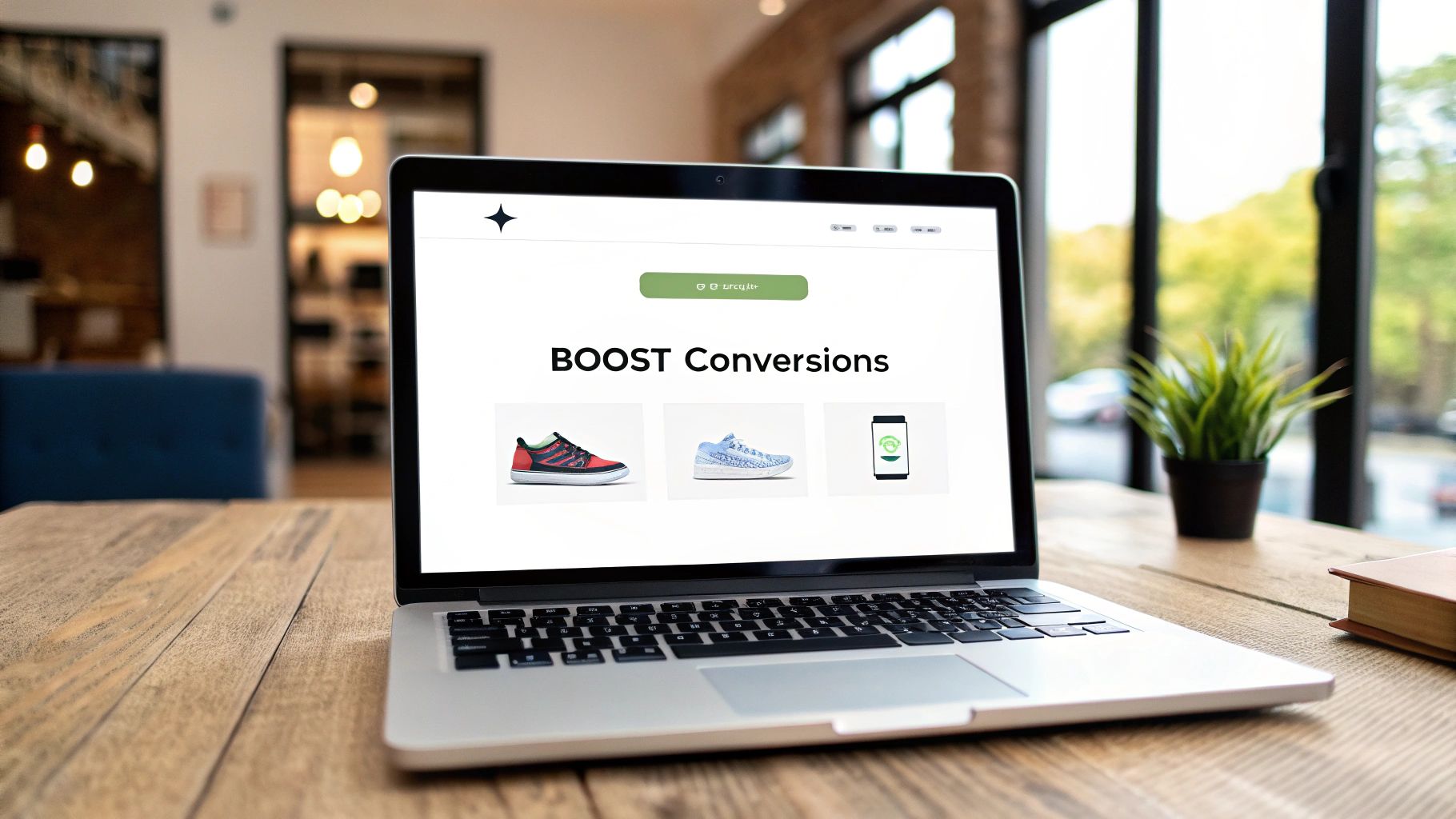
What separates a high-performing Shopify landing page from one that falls flat? It boils down to a few key elements working in harmony to create a persuasive and engaging experience for the user. Let's break down the vital components that consistently drive conversions for successful Shopify merchants.
Crafting Compelling Headlines
The headline is your first, and often only, opportunity to capture a visitor's attention. A strong headline on your Shopify landing page should immediately communicate the value proposition. It needs to clearly and concisely tell the customer what they'll gain. Think of it as a first impression; it sets the tone for the entire page.
For example, instead of a generic headline like "New Product Launch," try something more specific and benefit-driven like "Unlock 2X Productivity with Our Latest Time-Saving Gadget." This directly addresses the customer's needs and sparks their interest, leading naturally to the next crucial element: persuasive copy.
Writing Persuasive Copy That Converts
Compelling copy goes beyond simply listing product features. It speaks directly to customer pain points and offers solutions. Instead of stating, "Our shoes are made of breathable fabric," try "Experience all-day comfort with our breathable shoes, designed to keep your feet cool and dry even during intense workouts." This resonates with customers by addressing their needs and desires.
Focusing on benefits fosters a connection and builds trust, essential for encouraging visitors to take the next step: engaging with your visuals.
The Power of Visual Elements
Visuals are crucial for effectively conveying your message and creating an emotional connection with your audience. High-quality product photography is essential, presenting your products in the best possible light. Lifestyle images can further boost engagement by showing how your products fit into a customer's life. Consider incorporating videos to demonstrate product use or share customer testimonials.
Call-to-Action (CTA) Design
The call to action is the final piece of the puzzle. A well-designed CTA tells visitors exactly what action to take. Use strong action verbs like "Shop Now," "Get Started," or "Claim Your Discount." The CTA should be visually prominent, using contrasting colors and clear, concise language.
Placement is also key. Strategically position your CTA where it's easily visible and accessible. The effectiveness of Shopify landing pages is measured by their ability to convert visitors into customers. The average conversion rate for landing pages across all industries is around 4.3% to 6.6%.
However, optimized landing pages with clear CTAs, personalized content, and fast loading speeds can achieve much higher rates. For instance, personalized calls-to-action can convert 202% better than generic ones, and interactive elements like videos can boost conversions by up to 86%. Find more detailed statistics here. By optimizing these core elements, your Shopify landing page becomes a powerful engine for driving sales and achieving your business objectives.
Mobile-First Optimization for Shopify Landing Pages
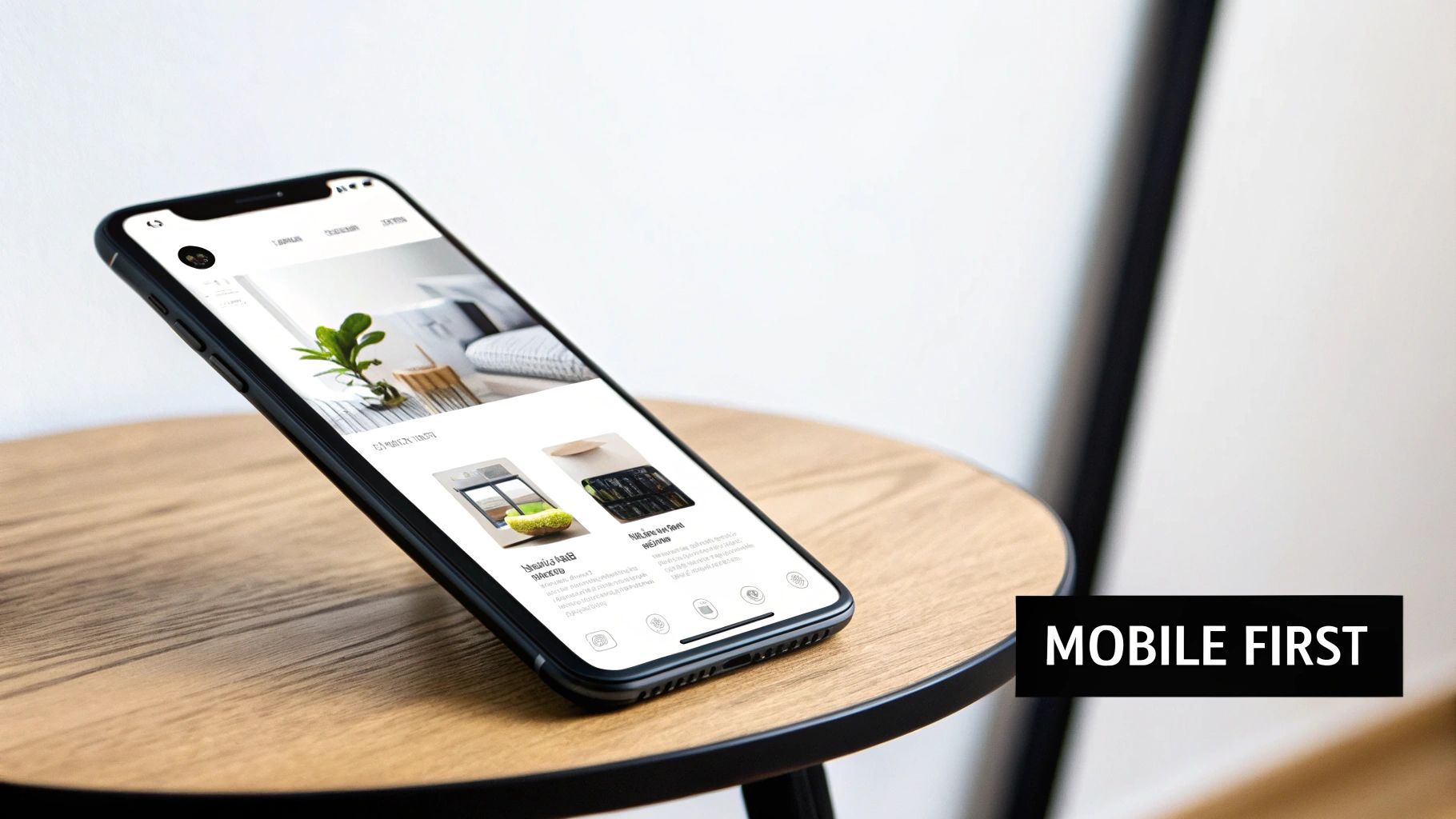
More people than ever shop on their phones. This makes mobile optimization essential for any Shopify landing page. If your page isn't mobile-friendly, you could lose customers and sales. This section explores creating a seamless mobile experience for your Shopify landing page.
Page Load Speed: A Critical Factor
Mobile users expect speed. A slow-loading page can lead to high bounce rates and lost conversions. Optimizing your landing page's speed is crucial. Start by compressing images. Large image files slow down your page. Use tools like TinyPNG to reduce file sizes without losing image quality. This ensures a quicker loading experience.
Minimize large videos and unnecessary code. Every element contributes to loading time. Streamlining content creates a faster, more efficient experience for mobile users.
Designing for Touch: The Importance of User Experience
Mobile users interact with their fingers, not a mouse. This requires a touch-friendly design. Ensure buttons and links are large enough to tap easily. Consider real-world use – a user on a bus should navigate easily.
Think about scrolling. Mobile users scroll quickly. Keep key information above the fold. Use clear visual cues to guide scrolling and highlight important content. This helps users find crucial information.
Content Adaptation for Mobile: Less is More
Mobile users often have shorter attention spans. Keep text concise, focusing on the core benefits. Use bullet points and short paragraphs to improve readability. This makes content digestible for on-the-go users.
Balance information with a streamlined experience. Provide enough detail to persuade, but avoid overwhelming users with text. A well-structured page with clear headings and visuals is key for mobile engagement.
Mobile Optimization Statistics: The Numbers Don’t Lie
Statistics show how crucial mobile optimization is. Companies with more landing pages generate more leads. Those with 31-40 landing pages generate seven times more leads than those with just 1-5. 82.9% of visitors access landing pages from mobile devices. Find more statistics here. This emphasizes the need for mobile-first experiences.
Testing Across Devices: Ensuring Seamless Performance
Finally, test your landing page on multiple devices. Ensure it looks and functions perfectly on various screen sizes and operating systems. Use a mobile simulator like BrowserStack or test on real devices. This is a critical final step. It ensures a smooth, consistent experience for all users. Prioritizing mobile optimization maximizes your Shopify landing page’s potential and reach.
Advanced Conversion Tactics for Shopify Landing Pages
Basic landing pages are a good starting point. But if you want to truly maximize their potential, you'll need to incorporate some advanced strategies. These tactics can significantly boost your conversion rates and overall performance. Let's explore some of the most effective methods.
Personalization: Tailoring the Experience
Personalization is all about creating a unique experience for each shopper. Imagine a brick-and-mortar store where the staff knows your name and remembers your past purchases. This personalized touch builds a connection. You can recreate this experience on your Shopify landing pages. By using data like traffic source, past purchases, and customer segments, you can tailor content to each individual.
For example, if a shopper clicks on a Facebook ad for a specific product, the landing page should feature that same item. This creates a seamless experience. Returning customers could see recommendations based on their past shopping history, adding another layer of personalization.
Dynamic Content: Adapting in Real-Time
Dynamic content takes personalization a step further. It allows your landing page to adapt in real-time based on how each visitor interacts with your site. Think of it as a webpage that instantly adjusts its content based on individual behavior. This ensures relevance, boosting engagement and conversion rates.
For example, if someone spends a lot of time browsing a particular product category, the landing page can dynamically display related items or special offers within that category. This real-time responsiveness keeps visitors engaged and encourages purchases.
Advanced Testing: Beyond A/B
A/B testing is a good practice, but advanced testing methods like multivariate testing can reveal even more powerful insights. Multivariate testing allows you to test different combinations of elements simultaneously. This helps identify the most effective combinations to maximize your conversions.
You can test various headlines, images, and call-to-actions (CTAs) all at once. The analysis reveals the winning combination, providing deeper insights into how different elements work together to influence visitor behavior.
Retargeting: Reconnecting with Lost Opportunities
Not everyone converts on their first visit. Retargeting allows you to reconnect with potential customers who showed initial interest but didn't complete a purchase. It’s a gentle nudge to remind them of what they left behind.
By showing targeted ads to those who abandoned their carts or viewed specific products, you can bring them back to your Shopify landing page and re-engage them with a personalized message. This often translates to more sales.
Integrated Marketing: Creating Seamless Customer Journeys
Integrating your landing pages with other marketing channels, like email marketing and SMS promotions, creates a seamless customer journey. This integrated approach maximizes customer lifetime value.
For instance, after a purchase, customers can be automatically enrolled in your loyalty program and receive tailored emails with exclusive offers. This strengthens customer relationships and encourages repeat business. By implementing these advanced tactics, you can transform your Shopify landing page into a high-performing conversion engine, driving sales and helping you achieve your business goals.
Measuring What Matters: Analytics for Shopify Landing Pages
Understanding your Shopify landing page performance is crucial for growth. Data without insights is just noise. This section will guide you through tracking and optimizing your landing pages, focusing on the metrics that truly matter for your business.
Setting Up Your Analytics Dashboard
Having the right tools is the first step. While Shopify Analytics offers basic data like a car's speedometer giving you speed and mileage, integrating Google Analytics provides a more comprehensive view, like a diagnostic tool analyzing engine performance. This powerful combination is essential for a complete understanding of your landing page's effectiveness.
Accurate tracking relies on proper setup. Ensure your Google Analytics account is correctly configured and linked to your Shopify store. This guarantees reliable data and actionable insights.
Key Performance Indicators (KPIs) for Landing Pages
Not all metrics are equal. Focus on KPIs that directly align with your goals. For sales-focused landing pages, track conversion rate, average order value, and revenue per visitor. If your goal is lead generation, prioritize submission rate, cost per lead, and lead quality.
For example, a high conversion rate coupled with a low average order value suggests you are attracting the right audience but not maximizing their spending. This might lead you to explore upselling or cross-selling strategies.
To better illustrate the key metrics you should be tracking, let's look at a table summarizing essential data points and how to improve them.
Key Landing Page Metrics to Track in Shopify Essential metrics for measuring landing page performance and what they tell you about your page effectiveness
| Metric | What It Measures | Target Range | How to Improve |
|---|---|---|---|
| Conversion Rate | Percentage of visitors who complete a desired action (e.g., purchase, signup) | Varies by industry, aim for 2% or higher | Improve call-to-action, simplify checkout process, offer incentives |
| Average Order Value (AOV) | Average amount spent per order | Varies by industry, track trends over time | Upselling, cross-selling, product bundles |
| Revenue Per Visitor (RPV) | Average revenue generated per visitor | Increase over time | Optimize pricing, improve conversion rate, increase AOV |
| Submission Rate | Percentage of visitors who submit a form | Aim for 5% or higher | Simplify forms, offer incentives, clear call-to-action |
| Cost Per Lead (CPL) | Cost of acquiring a new lead | Reduce over time | Optimize ad campaigns, improve targeting |
| Lead Quality | Percentage of leads that convert into customers | Increase over time | Refine lead qualification process, targeted content |
This table summarizes some of the most crucial metrics for evaluating your landing page's performance. Remember that consistent monitoring and optimization are key to improving these numbers.
Benchmarking: Understanding Your Performance Context
While comparing your metrics to industry benchmarks provides context, remember that generic averages can be misleading. It's more valuable to establish benchmarks based on your specific industry, product category, and price point.
A 2% conversion rate might appear low compared to a general ecommerce average, but it could be excellent for a high-ticket item landing page. This nuanced understanding helps you set realistic goals and effectively track progress.
Identifying Conversion Obstacles: Tools and Techniques
Data analysis reveals areas for improvement. Heatmaps visually represent where visitors click and scroll, highlighting areas of interest and potential friction points. Think of them like in-store security footage. Session recordings, like having a personal shopper observe customer interactions, allow you to watch actual user behavior, providing valuable insights. Funnel visualization helps identify drop-off points, like analyzing a checkout counter, showing where customers abandon their journey.
These tools can pinpoint areas for optimization, such as confusing navigation, unclear calls to action, or technical glitches, ensuring your efforts are focused and effective.
Iterative Optimization: A Continuous Improvement Framework
Landing page optimization is an ongoing process. Continuously analyze your data, test changes, and implement improvements based on user behavior. This iterative approach allows your landing pages to constantly evolve and maximize their potential. By embracing this data-driven framework, you'll see consistent growth and improved conversion rates.
Looking for pre-built sections to enhance your Shopify landing pages without coding? Section Store offers ready-made sections compatible with any theme. Add sections easily through your theme editor with a simple one-time fee per section, no subscriptions required. Transform your Shopify store today.



